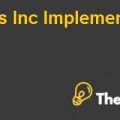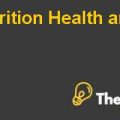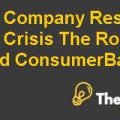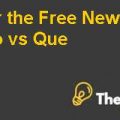The Diaper War: Kimberly Clark versus Procter and Gamble Case Study Solution
Porter’s Five Forces Analysis
Threat of New Entrants
Threat of new local entrants in the US disposable diaper industry is very low. The reason behind it is that the market for disposable diaper is very saturated with the only possibility of increasing demand through new innovative products or better features than competitors. High competitive rivalry also lead the industry to be unattractive for new entrants.Therefore, threat of entrants of better foreign competitors in US industry is high.
Threat of Substitution
Threat of substitution is very high. It can be analysed by the highly fluctuating market share during 1980s. The major reason behind the high threat of substitution is due to low differentiation among the products.
Competitive Rivalry
Competitive rivalry in the disposable diaper industry is intense. It can be analysed by the existing diaper war between the two dominant players of the industry. Both spend more of their amounts to promotional and R&D activities to get more market share.
Supplier’s Power
Supplier power in the industry is high. The factors tends to be higher supplier industry include the high dependence of manufacturers on plastic. However, K-C has a positive point in this regard, with about 60% of its supply coming from in-house sources.
Buyer’s Power
Buyer power in the industry is also high due to the availability of high competition in the market. Market saturation is also one of the factor leading to high buyer power in the industry. Along with it, little product differentiation reduce the cos of switching for buyers which lead to high buyer power in the industry.
Gap-closing Analysis
Being a close rival of P&G the gap analysis for K-C can be conducted on the basis of the gaps between the P&G and K-C. In order to become a market leader in disposable diaper industry K-C must analyse the gap in its quantitative and qualitative metrics and adopt the strategies to fill that gap. The qualitative metrics include the analysis of strengths of K-C over P&G, its weaknesses, its opportunities and threats. The quantitative metrics include the analysis of gaps between financial data of K-C and P&G.
Qualitative Gap Analysis (SWOT Analysis)
Strengths
The strengths of K-C over P&G include K-C’s efficiency in retail distribution channel, enabling the company to sell its product at a wide range than P&G. along with it, K-C has the largest in-house supply of wooden pulp required in the production i.e. 65% of its total supply of wooden pulp comes from its own wooden pulp manufacturing sector. It has provided flexibility to K-C and enabled the company to provide smooth supply of its diapers despite of highly fluctuating market shares during 1980s. Both the strengths can be utilized to increase sales and to reduce cost. Strong retail channel can be utilized to increase customer relationships which would result in attracting more customers and by utilizing strong in-house supply chain K-C can reduce the cost per unit and lower its prices than P&G to capture the middle market.
Weaknesses
K-C as compare to P&G has low focus over international markets, which has high growth opportunities than the USA’s saturated disposable diaper market. The major causes tending to K-C’s low focus over international market are its focus on incontinence products and on initiating specific gender disposable diapers, to compete with P&G’s His and Her disposable diapers. In order to fill the gap between P&G and its market position, K-C should focus on growing international markets rather than the USA’s saturated market. Along with it K-C has a limited product line as compare to P&G. Extended product line enables a company to become more popular in its consumers than its competitors. It should introduce more products to its product portfolio to fill the gap.
Opportunities
K-C has various opportunities as well to fill these gaps. These opportunities lie in gaining high market share in incontinence products as compare to P&G. This could be done through aggressive promotional techniques. Aggressive promotion will attract more customers towards K-C than P&G and would result in increasing sales and profits which could be utilized for geographical expansion in disposable diaper industry. Other opportunity for K-C lies in its largest in-house supply of wooden pulp. K-C could utilize its supply to make it more cost efficient and lower its pieces than P&G. it could also exploit the opportunity of global expansion towards the Japanese markets to adopt the Japanese technology of producing environmental friendly diapers.
Threats
The biggest threat for P&G is the entrance of Japanese Manufacturers with high technology in the USA’s market. These manufacturers can attract K-C’s customers towards their self by their technological features and environmental community’s support. K-C can avoid the threat by adopting the technology through aggressive geographical expansion towards Japan. Another threat for K-C is the increased environmental concerns which could result in increased costs for recycling projects and increased taxes for K-C. The threat can also be avoided by using biodegradable plastics through outsourcing supply of plastics from Japan.
Quantitative Gap Analysis (Analysis of Financial Statements)
The gaps between K-C and P&G can also be analysed by the analysis of financial statements using various profitability, leverage and turnover ratios of both the companies. The deep calculations of the ratios of both companies are given in the Exhibit B, and the gaps between the ratios are given in the Following Table-1:
Table 1:
| Gaps | Favourable/Unfavourable | ||
| 1989 | 1988 | ----------- | |
| Debt ratio | -7% | -3% | Favourable |
| Debt to equity ratio | -32% | -10% | Favourable |
| Operating margin | 3% | 3% | Favourable |
| Return on equity ratio | 1% | 4% | Favourable |
From the above table it can be analysed that the quantitative gaps between K-C and P&G are quite favourable for K-C than P&G, showing and strong financial performance of K-C over P&G. The negative gap of Debt ratio shows that K-C has less default risks as compared to P&G. The positive operating margin gap shows that K-C is more cost efficient in its operations than P&G. Along with it positive gap in its return on equity shows that K-C has more efficient utilization of its assets than P&G. Overall the gap analysis provide good hopes for K-C to have a parity in the market share with P&G, if it would continue its efficient financial performances and would fill the qualitative gaps with P&G............
This is just a sample partical work. Please place the order on the website to get your own originally done case solution.









